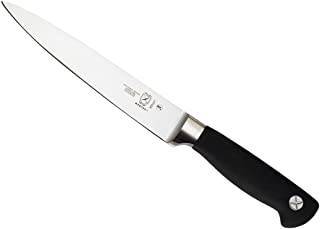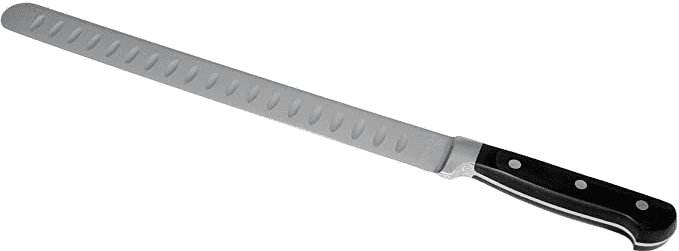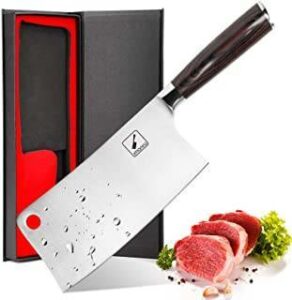KITCHEN KNIVES
What Are The Main Types of Kitchen Knives and Their Use?
23.01.2018
Introduction: Kitchen Knives
We have all seen the golf pro, walk over to his bag and pull out a different club, depending on where his ball lay on the green, or perhaps the mechanic at the local garage pull out a drawer on his tool box, with rows of types and sizes of wrenches. Knowing what tool fits the job at hand is the fundamental basis for getting the task completed. The same can be said about kitchen knives.
Just like the golf pro or mechanic, when cooking, we need to know what tools for the job we have sitting in our knife block.
And just like the professionals, having quality tools, and taking care of them and using them properly, sets us up for success in the kitchen.
Unlike in years past, you do not have to be a professional chef, or wealthy to have and maintain a good quality set of knives, so let’s cover some of the ins and outs of kitchen knives, how to use them, and how to keep and maintain them.
The Basics of Kitchen knives: Blade and Handle Material
Before we get into the different types of knives, let’s talk a bit about the knives overall. There are two main materials kitchen cutlery is made from. It comes down to a personal preference as to which to use:
- High Carbon steel – High Carbon steel knives are touted by Chefs, both professional and amateur alike, as being able to maintain a sharper edge longer than other materials. However, special care must be taken in regards to cleaning, and storing, as the untreated blades will rust if not coated with an oil after use. And the blades will develop a patina due to this after repeated use.
- Stainless Steel – Stainless steel on the other hand, doesn’t rust generally, but tends not to hold an edge as long, however, that tends to depend on use as well as what the user considers sharp. But suffice to say, a stainless steel blade is easier to keep pretty.
Apart from the blade material, something must be used for you to grasp the knife, the handle or scales as they are called can be made from many materials such as wood, bone, plastic, resin, and so on, they may even be a larger molded one piece construction, same as the blade.
When picking a scale material, care must be taken to insure ability to keep the knife clean and safe to use, a handle made of a porous wood for example, may be a breeding ground for germs and bacteria.
When picking out any knives to use in the kitchen, make sure the scales are securely attached to the tang, failure to do so may result in diced fingers instead of carrots.
Main types of kitchen knives
1. Boning Knives
Pictured: ZWILLING J.A. Henckels ZWILLING Flexible Boning Knife
Care to guess what a boning kitchen knife does? You guessed it, takes care of the bone problem.
Generally speaking, a boning knife has a long thin blade, somewhere between 5-8 inches long, tapers down to a very sharp point. This sharp point allows you to get right in there next to the bone when preparing meat to cook. Boning Knives tends to be a bit more flexible than perhaps most other knives in your block, with perhaps one exception. And that brings us to the next knife on our tool list.
2. Filet knife
Pictured: Mercer Culinary Renaissance Forged Fillet Knife
Very similar to the boning knife in looks, the filet knife tends to be longer, around 5-9 inches typically. While the boning knife is used on meat and poultry, filet knives go hand in hand with prepping fish. Filet knives are even more flexible than boning Knives, that combined with the extra length allows the ability to remove the most meat you can. You can use just any knife to clean a fish, however it just works so much better with the proper tool.
3. Paring Knife
Pictured: Wusthof CLASSIC Paring Knife
A good paring Knife in the kitchen is similar to a crescent wrench in the garage or a putting iron on the back nine, you just have to own at least one.
Paring knives can come in a few different blade shapes, but overall the thin, short blade, generally 3-4 inches, does all the utility work in the kitchen, paring, light boning, pitting, and I bet just about everyone has watched a mother or grandmother peel an apple with one.
4. Carving/Slicing
Pictured: MAIRICO Ultra Sharp Premium 11-inch Stainless Steel Carving Knife
With it’s long 8-14 inch blade, that comes to a fine point, the carving/slicing knife is one of the last knives used in the cooking process. A Carving/Slicing Knife does just that, It carves the meat up, and with the aid of that fine point, it is often used to serve meat to the plate. Anyone that has prepared a turkey on the holidays has enjoyed the use of a carving knife.. except those heathens that used some sort of electric (GASP) Knife.
If you want to win cool points with those at the dinner table, a few strokes on a sharpening steel, right before carving the meat will do the trick..even if it doesn’t need it.
5. Bread Knife
Pictured: Cuisinart C77TR-8BD Triple Rivet Collection 8″ Bread Knife
A bread knife is a carry over from days gone by, when fresher baked bread was the norm. Seeing less and less use these days, it’s still a handy knife to have around. And if you are like me, you can enjoy collecting them, from the days when vintage advertising was stamped on the blades.
A bread knife has a longish blade, 8-10 inches, with deep, large serrations. The blades are sometimes a little thicker than most other knives. It is not often you find a good Carbon steel bread knife, they tend to be stainless or some lesser quality metal. A gentle sawing motion on the bread is required, as any real force will quickly mangle your slice.
6. Cleaver
Pictured: imarku 7 Inch Meat Cleaver German High Carbon Stainless Steel
While it’s not actually a knife, no kitchen would be complete without a good cleaver. It’s thick, heavy, square shaped blade is tasked with the chore of chopping up meat or bone. It can also dice and chop veggies, open a lobster, just about anything that doesn’t require fine work. With the increased blade thickness, comes extra weight that drives a beveled edge into whatever gets in the way, without much fear of edge damage. Turned on it’s side, the wide flat blade is handy for crushing garlic, or scooping up whatever you just chopped. Once you start using a good cleaver, you will find more and more ways to use it.
7. Chef’s Knife
Pictured: Zwilling J.A. Henckels Professional S, Chef Knife
When you think kitchen knife, Chef’s Knife is what comes to most people’s mind. A chef’s knife is as personal to a chef as is his/her spouse, perhaps more so, a good one may be even harder to get and keep.
There are many different ways to use a chef’s knife, and thus, many different blade types. We could break this down further according to style blade, French style, Japanese or size, which ranges anywhere from 7-8 inches long, to 12-14 inches long. The Chef’s Knife is a all purpose, slicing, dicing, chopping, jack of all trade knife.
In the hands of someone with good knife skills, It is a pleasure to watch, although sometimes you can’t help but hold your breath, waiting for the blur of speed to lead to a mistake. Generally a Chef’s Knife has a wider blade than others in the kitchen, except the cleaver, which works with the varied styles of gripping the knife that is used.
Anyone that cooks more than a TV dinner, really needs a good Chef’s Knife or three.
Conclusion: Kitchen Knives
In the upcoming articles, we will talk about how to put together a set of kitchen knives if you are on a budget or not, how to care for your knives, we will talk about knife skills. We will review some knives, and talk about custom knives. And much more.












